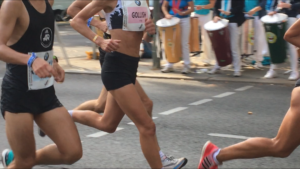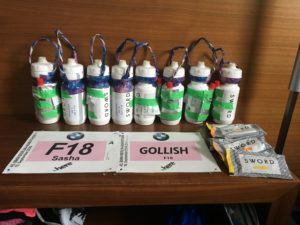It’s no secret I did not finish the Berlin Marathon, my first attempt at the distance.
I cramped. I had cramps in both legs from the top of my pelvis through to the tips of my toes. When the cramps struck it did not just feel like my legs would not go anymore, but that they were failing. And in a sense they did, I ended up a crumpled mess on the ground.
Like any runner, so many questions went racing through my head: ‘Why is this happening? Why is this happening to me? Why is this happening to me right now!?’
I was taken to a nearby hospital shortly after collapsing via ambulance. Immediately they did blood tests to see what was going on. I was offered a muscle relaxant and pain reliever to help deal with the cramping as the physicians looked to the lab report searching for answers as to what was causing the cramping and why I was in so much pain.
In the subsequent days following the marathon I started to ask myself ‘How did the cramping happen?’ I did not have the answers and I sought out the experts.

Historically cramping was believed to be caused by dehydration or an electrolyte imbalance1.
We now know that’s not true. Well, in some cases it is not true. Dehydration can cause cramping. However, the whole story with cramping is that’s one of your body’s last lines of defence; cramping is caused by your body trying to protect itself.
Think of it this way, you are willing yourself forward. ‘No, head, my legs are not tired. No, legs, you are not tired.’ You repeat over and over again: ‘I will push forward.’ If you really push yourself to your physical limits your body may eventually push back.
Here some facts from my day to dispel the myth that I cramped due to lack of glucose or hydration:
- I was consuming water bottles with Sword Nutrition every 5km. Each bottle had just over a 1/2 serving of Sword in 7 oz of water. I would consume this over 1 to 2km. Roughly speaking that 177mL and 70kCals (in training I noted that I could not consume the last 1oz of liquid in my bottle. 6oz ~=177mL)
- Taped to my water bottle was an Endurance Tap. Each serving of Endurance Tap provides 100kCal’s of energy (25g or carbohydrate). I would consume this ~3km after the aid station in two sips (i.e. at 8k, 13k, 18k, etc.)
- I was running at an average of 3:30/km, crossing 5km in about 17:30, which means I would have passed three aid stations in under an hour for a total consumption of 531mL of water and 510kCal/127.5g of carbohydrate. The research shows us that most people can tolerate upwards of 360kCal/90g of CHO; I had no GI issues that day.
- I had consumed my regular morning pre-race/long run meal, Greek Yogurt with a touch of honey topped with some plain dry cereal, a slice of toast, a cup of coffee, and a bottle of Sword.
So what might have caused my cramping? I have a few theories, which thanks to those experts who have walked me through what have happened I can share with you.

At 5km into the race a pace car got behind us and was honking it’s horn repeatedly and aggressively such that it could pass us. When I did not at first hear the car coming up behind us, the sound of the horn startled me, causing my heart rate to spike (the spike went from ~140BPM to ~175BPM). This wouldn’t necessarily be catastrophic, but my heart rate never again dropped below ~160BPM. Likely what happened was a period of anaerobic effort that caused me to perform at a higher HR. As a result, I may not have been able to clear or buffer the blood lactate.
The second contributing factor may have been the surface I trained on over the summer. I spent my summer up at the cottage, which sits nestled at the bottom of an escapement on the beaches of Georgian Bay, it’s spectacular. It is also mainly dirt roads and the roads that are paved are a thin layer of asphalt atop granular (#EngiNerdAlert!). During the race, it felt like substantially higher forces going into my feet and up through my legs. Yes, it is anecdotal, and just a feeling, but even if that was the case, we have the science that says psychology is just as powerful as physiology2. But it likely wasn’t just psychological. I likely was suffering physically due to the pounding of the higher forces of denser pavement; Alex Hutchinson makes a similar comment about his marathon in Endure3.
The failure of this event is still very raw for me. Trying to understand what caused the cramping can only bring some comfort. Every day it gets easier to move forward; I’ve learned so much about my body in a marathon and cramping along the way. Thinking about all the positive things that happened during the race and training make it easier.
Marathon I’m not done with you, I’ll see you again one day again.
_______
- Hutchinson, A (2012). Dehydration Doesn’t Cause Muscle Cramps? New research continues to raise questions about what really causes muscle cramps. Runners World. Accessed online: www.runnersworld.com
- Magnus, S (2018). The Pre-Race Moment: Taking Advantage of where Psychology and Biology Intersect. The Science of Running. Accessed online: www.scienceofrunning.com
- Hutchinson, A (2018). Endure: Mind, Body, and the Curiously Elastic Limits of Human Performance. William Morrow, NY.







Sasha, I can absolutely attest to higher force levels significantly impacting performance. My first ultra had a short few mile section on old cement roads in an industrial district that were meant to support heavy tractor trailers. That occurred at about the 10 mile mark and I dropped out at the 21 mile mark feeling like I had run the full race and then some. It was brutal.